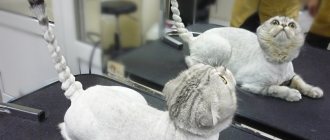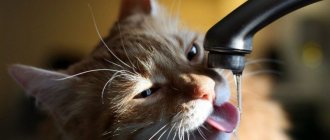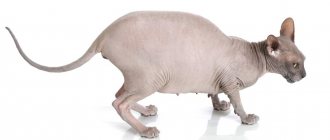It is easier to accustom a small kitten to water procedures than an adult. Owners of a sexually mature animal are faced with the following problem: how to bathe a cat if it is afraid of water.
Experienced breeders advise gradually accustoming your pet to bathing, not forgetting about little tricks.
You should act carefully, without forcing your pet, without showing aggression.
Patience and a friendly attitude will help you find contact even with an adult wayward animal.
Causes of fear
Fear and aversion to water is a natural cat reaction.
Your pet can and should be bathed. The cause of fear is caused by many factors. This may be an unusual environment, too bright light, noise and shouting of people.
Situation
In the bathroom, the animal's movements are constrained, sounds seem sharp, and the sound of water is frightening. Often the owner shouts at the cat if it behaves too aggressively.
The animal does not like that in the bathroom it cannot gain stability, clinging to its claws, while being forcibly held down.
Reaction to shower and hot water
Water flows out of the shower spray noisily and in large streams, which greatly frightens your pet. The animal perceives the hissing pressure of water as a living aggressive creature.
Fluid temperature is not always adjusted (too cold or too hot). When swimming, these factors should be taken into account first.
How often
The maximum interval between baths can be anything, since most cats do not need regular bathing. Animals that visit the street are given hygiene procedures every 1-2 months. The rest are bathed when an odor or dirt appears.
The minimum gap is more important. You can’t bathe your pet too often, because... During each procedure, the protective layer is washed off from the surface of the skin. If you wash your cat too regularly, your cat's sebaceous glands begin to secrete more oil. As a result, the fur quickly gets dirty, and bathing has to be done more often.
Later, dandruff and itching appear. The animal begins to scratch itself. Due to the disruption of the skin's barrier function, infection becomes easier.
Oily wool creates optimal conditions for the development of bacteria: it is too dense and makes ventilation difficult, and moisture evaporates from it less easily. This is fraught with the development of dermatological diseases.
If you are going to bathe your pet with plain water, this can be done every 3-5 days. It is better to use shampoos no more than once every 2-3 weeks. It is advisable to carry out hygiene procedures as rarely as possible so as not to harm the cat.
Tips for the owner: how to wash a cat
To prevent your cat from experiencing stress during bathing, it should be accustomed to the procedure from an early age. Kittens begin to be washed after the complete replacement of milk teeth. At first, they simply dip their paws in water.
How to bathe an adult animal:
- Remove foreign objects from the bathroom, especially those that rattle a lot (buckets, basins, bowls).
- All windows are closed to avoid drafts.
In the bathroom, a towel and pet shampoo are placed at arm's length so that they can be quickly grabbed.- The water temperature and pressure in the mixer are adjusted in advance so as not to frighten the animal during the bathing process.
- The door to the bathroom is closed, sudden sounds and movements are avoided.
- Select a suitable water temperature in the mixer at + 35 ° C, fill the bath one third with liquid.
- The cat is taken by the withers and placed in a container. Wash the paws and body with water (it is important that the liquid does not get into the eyes, nose, ears).
- A small amount of shampoo is squeezed into the palm of your hand, rubbed, applied to the pet’s fur, and foamed. While bathing, the cat is calmed down, talked to calmly and affectionately.
- The foam is washed off with a shower hose, the pressure is set to low so as not to frighten the pet.
If necessary, the entire procedure is repeated twice.
The shampoo is washed off thoroughly: cats lick themselves, and the remains of the detergent can get on the tongue and into the esophagus, harming their health.
Then the pet is dried with a towel; you can dry it with a hairdryer if the cat is not afraid of its noise.
What to do next?
To wash a cat, two buckets of shampoo will definitely be enough for you, and then you need to start rinsing. Clean water has already been collected in the bucket, and you can add conditioner there, if, of course, the cat has calmed down enough and you have such an opportunity. If he is still afraid of water, then you can do without it. Rinse the coat thoroughly, moving the cat from one bucket to another filled with clean water two or three times. Once you're done, turn off the shower, place the cat in the bottom of the bathtub on a mat, and wring out the fur with your hand. Cover the animal with a sheet and remove it from the bath.
Preparation for water procedures
Prepare for washing the cat in advance.
Everything necessary for the procedure is laid out nearby, and unnecessary items are removed. Protect your pet's ears with large balls of cotton wool. They should be large enough to cover the ear canal, and after the procedure it will not be difficult to remove them.
To clean the fur, use special shampoos for animals. Detergents for humans are not suitable for them: such products have a different acidity level (PH) and cause irritation on the skin of pets.
Nail trimming
To protect yourself and the animal if it scratches, the cat’s claws are cut before taking a bath. Frightened cats often try to get out of the bathtub by climbing up their owner's arms.
An animal without claws will cause fewer injuries.
Use of special devices
Pet stores sell mesh bags for bathing cats.
The animal is placed in this bag, the headband is fastened around the pet's neck. The device will help pacify your pet: he will not scratch or try to get out of the water.
Large mesh cells do not prevent the penetration of water and detergents into the wool, and bathing will take place without problems. The owner will have both hands free, he can easily soap the pet and rinse off the detergent.
Bath equipment
It is important to prepare the bathroom before bathing your cat at home. A soft mat is placed at the bottom of the bath, which fits tightly to the surface.
Place 2 buckets with a volume of up to 15 liters nearby, wide but shallow, and fill them with warm water. Metal containers create a lot of noise, so it is better to choose plastic. Several caps of concentrated pet detergent are dissolved in one.
It is better not to use basins: they take up a lot of space.
Detergents are placed on the side of the bathroom so that they are easy to reach.
The shower is turned on at the lowest power so that the noise of the water does not frighten the pet. Place old towels or clean sheets nearby, which absorb liquid well after bathing.
Assistant
If a cat bites or runs away from the bath, and there is no special device to restrain it, the help of another family member is needed.
It is easier to bathe a cat without consequences together: the assistant will hold the pet, and the owner will wash the animal without difficulty.
What not to do to wash a cat?
- There is no need to open the tap all the way and put the cat in the bathtub when water is pouring in with a roar.
- There is no need to turn on the shower at full power and direct it at the animal.
- There is no need to use dog shampoo, much less dishwashing detergent, to wash cats.
- There is no need to pour shampoo from the bottle directly onto the coat, especially dry hair.
- There is no need to put cotton in your ears, it will only irritate.
- There is no need to give sedatives, they do more harm than good.
Algorithm for bathing a pet
All actions are performed without haste:
- The animal is picked up, stroked, calmed, and taken to the bathroom. There, the hind legs are fixed with the right hand, holding the animal under the abdomen. With your right hand, grab the front paws, picking up the cat under the ribs.
As soon as the animal is securely fixed, it is carefully immersed in a basin of water, the hind legs are released so that the pet rests them on the bottom of the container.- The front paws are held with the left hand, and the cat is washed with the right. The animal must be immersed in water up to its neck.
- The soap solution is applied to the entire coat (except the head) and the integument is washed with light massaging movements. Areas where vegetation is dense are especially good for cleaning.
- It is not recommended for an overly emotional or fearful pet to wash its hair. This part of the body always remains clean. The muzzle is wiped with a damp towel.
- As soon as bathing in a bucket of soapy water is completed, the cat is transferred to a container with clean liquid. The animal's fur is thoroughly washed to remove any remaining foam.
Water from the shower will help to completely clean the cat of soap.
You can empty the first bucket of dirty water, rinse it, and fill it with clean water. Then the animal is once again transplanted into the container, and its fur is washed well.
After bathing, it is important to thoroughly dry your pet's coat with a clean cloth or hairdryer that absorbs moisture.
The first option is preferable: the noise of the unit is additional stress for the cat.
The owner makes sure that there are no drafts in the house during drying: a wet pet can easily catch a cold. Kittens and older animals with weakened immune systems are especially protected.
A mustachioed pet that has passed all the tests with dignity is given a treat to relieve stress after contact with water.
How and when to give a kitten a bath day
You can bathe a kitten no more than two or three times a year. Weekly and, especially, daily water treatments are absolutely useless to him. Washing your kitten just because you want to is putting him under a lot of stress, and not only that! The skin and fur of our pets are protected by a special substance that helps regulate heat exchange and, most importantly, protects the animal’s body from various infections. Daily bathing disrupts this natural protective barrier, resulting in kittens often getting sick. You become a regular visitor to a veterinary clinic, spend a lot of money on treating your pet, stuff it with medications, give it injections, but for some reason there is no improvement. But all that would need to be done is to leave the pet alone and let it recover!
Kittens under maternal care, or older ones living in a clean, well-groomed home, do not need bathing at all. The most that may be required is to periodically wipe the soiled paws, fur or area under the tail with a piece of damp terry cloth or, if this is not available, with wet wipes intended for the care of infants. If your pet is afraid of even such simple hygiene procedures, think about what will happen if you put him in a bowl of water!
Of course, there are no rules without exceptions. Babies of some cat breeds are favorable not only to puddles in the yard, but also splash with great pleasure in the bathtub, love to bathe in the shower, and playing with a stream of water from the tap is their daily favorite pastime. Norwegian forest kittens, small Maine Coons, baby Bengal cats and some other breeds are distinguished by this love of water. There is no need to wean them off this! If your little pet loves to play with the merrily babbling streams and jumps into the sink every time you need to wash your face or brush your teeth, don’t interfere with his interest. Just make the water warmer so that the baby does not get too cold, and after bathing, dry him with a towel or hairdryer and do not let him out of the warm room until he is completely dry.
A real wash, using a special shampoo, may only be required for a kitten in exceptional cases. This procedure is practically no different from bathing an adult animal, with the only exception that you can hold the baby yourself without resorting to outside help. In addition to a basin, shampoo and a few towels, stock up on a handful of cat treats to reward your pet for being patient and distract him from his sad thoughts when things get really overwhelming. Don’t think that cats (especially their babies) understand little. Quite the opposite! Most of them seem to read information from your head. A calm, confident, gentle voice, leisurely movements, and, most importantly, words of approval, supported by another delicious piece, work wonders! The kitten will quickly understand that nothing bad will be done to him. On the contrary, they will treat you to something tasty, pet you and caress you. As for the water and soap bubbles, these are minor things, you can bear with it. You will be surprised, but the second or third bath will be much calmer, and soon your little pet will be jumping into a bowl of water, anticipating a new treat.
How to teach a cat to bathe
Each owner has his own secrets and approaches to his beloved pet. All of them can be combined into a list of simple recommendations that will reduce the innate fear of water in cats.
Advice from experienced breeders:
It is worth teaching your cat to take water treatments from an early age. From the age of 2 months, the kitten can be placed in a small basin and its paws can be gently washed. Growing up, a seasoned pet will not be afraid of water.- A few days before bathing, an adult animal is placed in an empty basin, having first filled it not with water, but with its favorite toys. At the same time, the animal is given a treat or catnip: the cat will not associate the bathroom and basin with danger.
- As soon as the animal gets used to the empty container, fill it a few centimeters with warm water and put toys in it. The cat is lured with interesting objects or treats, and invited to climb into the basin.
- If your pet is too nervous when taking water procedures, it is better not to keep him in the bathroom for a long time. The animal is lightly rinsed, and bathing is postponed to the next time. The procedure is repeated regularly, do not forget about it.
The pet is combed before washing - this makes washing the fur easier and faster. This removes tangles and dirt, and makes the bathing process easier.
If the cat, after all the tricks, is not used to swimming calmly, contact a groomer. A professional will be able to wash the animal quickly and without consequences, making the task easier for the owner.
How to properly bathe a shy cat when he scratches?
Many people note that it can be even easier to bathe a small kitten than an adult animal. Kittens are not so timid; they quickly come to terms with bathing as if it were inevitable, even if they don’t like the process. In addition, it is easier to handle babies by holding them in the desired position.
A domestic cat, for example, can suddenly show powerful resistance: it will scream, struggle and scratch, splashing a lot of water around.
But there are some useful tips that will help you cope with bathing:
- Get your pet used to bathing. Let the whole process turn into a kind of training. For example, you can treat your cat with his favorite treat after a bath.
- Be kind , speak gently, and never yell at the animal.
- Keep in mind that bathing can be stressful for your cat. Try to distract him with toys and conversation.
- Be persistent , but don't frighten your pet even more.
- The optimal solution is to bathe the cat together if it resists strongly. One person will be able to secure the animal well (you can only hold it by the paws and withers, you cannot squeeze it across the body), and the second will do the washing.
The main thing is to take into account all the nuances, do not offend or frighten the cat, do not provoke aggression from him.
Rules
When carrying out the procedure, a number of rules must be followed. They will help you avoid serious mistakes, stress and fear in your animal.
There are several of them:
- do not bathe the cat immediately after eating - an unusual situation for him can cause vomiting;
- You should not immerse your cat’s head in water – this will not only scare it, but will also lead to the development of diseases;
- be sure to comb your long-haired animal before the event;
- remove existing tangles if they are present - the skin under the tangle will not be washed, and the tangle itself will not go anywhere;
- follow the dosages of medications and anti-parasite shampoos to prevent the cat from being poisoned;
- You cannot scold, shout, or offend your pet while washing - this will only scare him and will not pacify his aggression.
If the rules are followed, the event will take place without risk to the health of the cat and owner.
Is it possible to bathe a cat with shampoos intended for humans?
If the cat is very dirty and the pet shampoo suddenly runs out, as an exception, you can use human shampoo. It will not cause much harm to the animal. However, this does not mean that cats can be washed with the same products that are intended for our hair. Do not forget that the acid-base balance between us and our pets is quite different, which will inevitably affect the condition of the coat and skin. If your cat likes to roll around in the mud, keep a couple of jars of pet shampoo on hand.
Causes of a cat's fear of water
Zoologists, interested in this issue, found that cats are absolutely not afraid of water. Animals are afraid of the consequences of contact with it. A number of main reasons why a cat avoids bathing:
- risk of hypothermia;
- possibility of overheating;
- increased odor upon contact with water;
- fear of attack;
- stress from the imposed bathing procedure.
Sometimes the reasons include the animal's fear of contracting bacteria or infections, as well as the fear of being deaf. However, these are more likely the reasons of the cat owners, rather than the animals themselves.
There are a number of reasons why cats don't like water.
Risk of hypothermia
A cat's fur has a special structure, specific composition and smell. Between the skin and fur of the animal there is a kind of air layer that retains heat. After contact with water, the fur loses its heat-insulating functions and the pet begins to freeze and shiver even in a warm room. In addition, after bathing, the cat’s body temperature decreases by 5–7°, which is why the purr cannot warm up until it dries completely. Of course, at home, a cat is unlikely to run the risk of getting too cold, but at the genetic level, the instinct of self-preservation is triggered, and the pet diligently avoids water treatments.
Possibility of overheating
The air accumulated in a cat's fur can not only protect the animal from the cold, but also save it from overheating on a hot day. The air cushion prevents the sun's rays from heating the animal's delicate skin. The dog escapes the heat by sticking out its tongue and breathing frequently. Cats, alas, don’t know how to do this, so in order not to get their coats wet, they avoid bodies of water even in the heat.
Increased odor upon contact with water
Every cat has a hunter's instinct from birth. She, like a sniper, can wait for hours for a victim in a motionless state. The wet skin begins to intensely emit a specific odor because the body temperature begins to rise sharply. This “amber” can be smelled by potential prey, and the musky runs the risk of being left without lunch. In order not to remain hungry, the cat tries not to come into contact with water.
Wet fur prevents the cat from catching prey and makes it a target for attack.
Fear of attack
A wet cat, spreading its scent, can itself become an object of attack by a stronger and larger predator. Sitting in ambush, the animal does not have the opportunity to lick itself thoroughly to eliminate the incriminating odor. In addition, wet fur becomes heavy and makes it difficult for the cat to quickly retreat in case of danger. It is clear that this does not threaten the pet, but no one has canceled the instinct of self-preservation.
Fear of bacteria and infection
Dry cat fur repels dirt and dust, which contain large amounts of bacteria and pathogens. The wet one, on the contrary, collects them. During licking, pathogenic microflora enter the stomach and can cause significant harm to the pet’s health. Some felinologists believe that a cat intuitively understands the consequences of water procedures for the body.
Fear of going deaf
Hearing, along with other senses, is of great importance for a cat. Water that gets into the ears while swimming can cause inflammation and even lead to complete deafness. It is very difficult for a deaf animal to adapt to the world of sounds, so the cat, anticipating another trouble, is careful of water.
Stress from the imposed bathing procedure
The cat is incredibly clean. She bathes herself several times a day. The pet considers bathing to be a pointless procedure that violates the cat’s comfort. The animal is sincerely perplexed why the owner put it in the hated chlorinated water and lathers it with an incomprehensible substance with a synthetic smell. In addition, the owner’s touch during bath procedures is not always delicate. The cat has no escape route and has to forcefully endure the imposed process.
Animals consider bathing a procedure that has no meaning
It is clear why the purr has difficulty withstanding this “execution” and sometimes falls into a state of stress.
Video: why cats are afraid of water
Despite their dislike of the water element, cats are excellent swimmers. Why do they need this? The reason is simple - the same instinct of self-preservation. In extreme conditions, the pet has to swim, sometimes over quite long distances. The fluffy beauty's ability to swim has been developed since birth. Even one-month-old kittens that fall into the water swim like dogs, quickly moving their paws.
Features of washing cats of different breeds
Some breeds have their own characteristics for water procedures. Individuals with short hair bathe less often than their long-haired counterparts. The Sphynx breed has many different rumors about washing; they supposedly need to be bathed every week.
In fact, it is much better to wipe them regularly with a damp cloth or cloth. You should only bathe if you are heavily soiled. The Burmese cat has a very beautiful shiny coat, the appearance of which must be maintained in this condition. If you do not carry out care procedures, the cover may become similar to hedgehog spines. Such pets need to be regularly wiped with chamois and wet wipes. Such manipulations will give the hair a characteristic beautiful shine.
Brushing is done once a week. To do this, you can use a special glove, brush, and antistatic agent.
Coons and Britons have particularly sensitive skin. For them, you should carefully select veterinary shampoos that are suitable for the animal’s coat type. If you use low-quality cosmetics, the animal’s skin may begin to itch, dandruff or other negative consequences may appear.
If your pet is very afraid of water
Veterinarians advise not to rush into water procedures, but to give the baby time to adapt to a new place and get used to people
You can accustom your pet to water procedures only after changing teeth. When the kitten has played enough and is tired, well-fed, healthy and happy. The baby should see that his owners are not afraid of water, wash themselves often, and this is a natural process for all family members. Cats are observant and intelligent; they notice and remember a lot.
If your kitten is unsure about its cleanliness, it is best to treat it with flea and tick spray and give it a deworming tablet.
When bathing for the first time indoors, nothing should distract or frighten the animal. If the first procedure does not go smoothly, the next one will be even more difficult. The cat should be washed by a person she trusts. The first bath should be short so that stress does not last long. Your pet should not be allowed to freeze, as it will remember not only water procedures, but also the cold after them.
If at each subsequent bath the cat behaves inappropriately and as if doing it for the first time, it is better to give up trying and switch to partial washing or using dry shampoo. The product is sold in pharmacies just for those animals that are terribly afraid of water. Dry shampoo is a spray that is applied to the coat and then thoroughly combed out by the pet owner. The product copes well with pollution, protects the pet’s nervous system and maintains a trusting relationship between the animal and the person.
Other options for ridding an animal of dirt
With partial cleaning, the pet gets rid of dirt, and its psyche remains protected
You can also bathe not the entire animal, but only the back, sides, tail or paws. All you need is a minimum of water, a good sponge, a brush and a little patience. A wet rag does not scare a cat as much as a container of water or a strong stream of water. Contaminants are removed using special products or dry shampoo. You need to move the sponge or brush strictly according to the hair growth, not forgetting that you cannot stroke the cat against the grain, as he does not like it.
Tail
It should be handled with caution, since felines themselves are sensitive to their mood indicators. You shouldn’t pick it up, squeeze it, or twist it in different directions.
You need to lightly touch the sponge and gently move it, washing away the dirt, holding the cat by the head. Paws. They can be wiped with a cloth or dipped in a shallow container with soapy water. Cats that often walk outside get used to this procedure just as well as dogs. Sides. A greasy side, stomach or back can be washed off with a spray that will need to be removed with a brush, or a wet sponge with a special detergent. Muzzle. It is easy to clean with a damp cloth or bring the animal to a water tap and wash it gently, taking care not to get water into the nose or ears. Head. The cat cannot reach everywhere to lick itself, and on the head, between the ears, its fur sometimes becomes greasy. It is recommended to wash contaminated areas on the head with dry shampoo or under a low-pressure tap if the animal is not afraid of such procedures.
Why you should wash your pet cats
Any cat needs to be washed at least once every 3-4 months. If the animal is outdoors quite often, then the interval between washing can be only a couple of months, while cleaning the paws from street dirt should occur regularly. This type of care is required to help your pet keep its coat attractive and healthy.
In what cases may unscheduled washing of an animal be necessary?
- Before the exhibition, if we are talking about purebred cats. In this case, the frequency of water procedures may increase.
- In situations where the animal gets dirty. Especially in those moments when there are harmful or chemical contaminants on the wool. If you do not wash them off with water and additional products, the animal may become poisoned.
- During periods of excessive shedding. When a cat washes itself, it swallows hairs, causing the fur in its stomach to form into lumps. If your pet does not regurgitate them, digestive problems may occur, including intestinal obstruction. This risk increases with intense shedding and in cases where the cat's fur is very long and thick.
In addition, washing the cat allows you to simplify the subsequent process of combing the fur, so that tangles do not form, which will then have to be cut.
Cats that are not afraid of water
Water is not at all dangerous for some felines. Wild cats are not only not afraid of bodies of water, but also spend a lot of time in them. Waterfowl wild cats include:
- tiger;
- jaguar;
- jaguarundi;
- serval;
- Sumatran cat;
- speckled cat (civet cat-fisher).
Cats living in the wild are absolutely not afraid of the consequences of getting their fur wet. They truly enjoy contact with water.
One of the most aquatic wild cats is the speckled cat (wyverrina). It feeds on fish, which it catches by diving 2–3 meters deep. The fishing cat has membranes on its front paws that help it catch fish underwater.
Among domestic animals there are also curious individuals who are absolutely not afraid of water procedures. They happily play with the stream of water, catch their reflection in it, and the bravest ones even take baths with their owners. The following breeds are classified as domestic “swimmers”:
- sphinx;
- Siamese;
- Bengali;
- Cornish Rex;
- Turkish van;
- Kurilian and American bobtail;
- Abyssinian;
- Maine Coon;
- Savannah (a hybrid of a domestic cat and an American serval);
- Norwegian forest;
- sokoke.
The biggest fans of bath treatments are Siamese cats. They go into the water not for hygiene purposes, but to get real pleasure. And Kurilian bobtails not only frolic in the water, but also dive with pleasure.
Our first cat, Sonya, was probably an alien animal. She loved water. We found her in the entrance as a small kitten, we thought that pussy was an ordinary mongrel. It turned out to be a Turkish Angora. Sonya had snow-white and very fluffy fur, so the cat had to be washed quite often. The reasons for the cat’s reverent love for water are difficult to guess. Maybe because, being just a baby, she couldn’t lick herself after going to the litter box, and we constantly washed her under the tap with warm water. Maybe he just liked the sound of water. When one of the family members washed their face, our beauty always watched the process, and sometimes she herself jumped onto the washbasin and touched the water with her paw. And if someone was taking a bath, she couldn’t miss it. She screamed at the door, demanded to be let in, and then jumped onto the side of the bathroom and walked around it. One day I was washing, and Sonya caught the foam with her paw, accidentally slipped and fell into the water with me. And she wasn’t at all scared, but swam like a dog. Such an amazing Catdog. And she was absolutely not afraid to dry her fur with a hairdryer, and even enjoyed it. And this is no exception to the rule. Our relatives have two cats who are absolutely calm about water, and the older cat constantly wets his head under the tap in the heat.
Video: waterfowl cats
Photo gallery: domestic cat breeds that are not afraid of water
Cornish Rex is not averse to jumping into a container of water
Turkish Van cats are always ready for water treatments
Bobtails love not only to splash around, but also to dive into the water
An Abyssinian cat will easily keep a bathing owner company
The Norwegian Forest Cat is not afraid to get its luxurious coat wet.
Savannah is a big fan of water treatments
In order for a Maine Coon to love water, it must be taught to bathe from childhood.
Bengal cats are not afraid of the consequences of contact with water
The Siamese cat is the biggest fan of splashing in the water.
Sphynx cats have a positive attitude towards H2O
The graceful sukoke is not at all afraid of the water element
Owners who want to buy a cat that is ready to take a bath with Spartan calm should take a closer look at waterfowl breeds.











